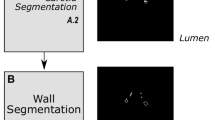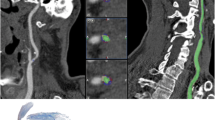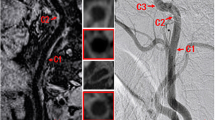Abstract
The purpose of this study was to evaluate the influence of advanced software assistance on the assessment of carotid artery stenosis; particularly, the inter-observer variability of readers with different level of experience is to be investigated. Forty patients with suspected carotid artery stenosis received head and neck dual-energy CT angiography as part of their pre-interventional workup. Four blinded readers with different levels of experience performed standard imaging interpretation. At least 1 day later, they performed quantification using an advanced vessel analysis software including automatic dual-energy bone and hard plaque removal, automatic and semiautomatic vessel segmentation, as well as creation of curved planar reformation. Results were evaluated for the reproducibility of stenosis quantification of different readers by calculating the kappa and correlation values. Consensus reading of the two most experienced readers was used as the standard of reference. For standard imaging interpretation, experienced readers reached very good (k = 0.85) and good (k = 0.78) inter-observer variability. Inexperienced readers achieved moderate (k = 0.6) and fair (k = 0.24) results. Sensitivity values 80%, 91%, 83%, 77% and specificity values 100%, 84%, 82%, 53% were achieved for significant area stenosis >70%. For grading using advanced vessel analysis software, all readers achieved good inter-observer variability (k = 0.77, 0.72, 0.71, and 0.77). Specificity values of 97%, 95%, 95%, 93% and sensitivity values of 84%, 78%, 86%, 92% were achieved. In conclusion, when supported by advanced vessel analysis software, experienced readers are able to achieve good reproducibility. Even inexperienced readers are able to achieve good results in the assessment of carotid artery stenosis when using advanced vessel analysis software.




Similar content being viewed by others
References
Lell M, Fellner C, Baum U, Hothorn T, Steiner R, Lang W, Bautz W, Fellner FA: Evaluation of carotid artery stenosis with multisection CT and MR imaging: influence of imaging modality and postprocessing. AJNR Am J Neuroradiol 28:104–110, 2007
Hollingworth W, Nathens AB, Kanne JP, Crandall ML, Crummy TA, Hallam DK, Wang MC, Jarvik JG: The diagnostic accuracy of computed tomography angiography for traumatic or atherosclerotic lesions of the carotid and vertebral arteries: a systematic review. Eur J Radiol 48:88–102, 2003
Josephson SA, Bryant SO, Mak HK, Johnston SC, Dillon WP, Smith WS: Evaluation of carotid stenosis using ct angiography in the initial evaluation of stroke and TIA. Neurology 63:457–460, 2004
Koelemay MJW, Nederkoorn PJ, Reitsma JB, Majoie CB: Systematic review of computed tomographic angiography for assessment of carotid artery disease. Stroke 35:2306–2312, 2004
Bhargavan M, Kaye AH, Forman HP, Sunshine JH: Workload of radiologists in united states in 2006–2007 and trends since 1991–1992. Radiology 252:458–467, 2009
Bhargavan M: Trends in the utilization of medical procedures that use ionizing radiation. Health Phys 95:612–627, 2008
Boone JM, Brunberg JA: Computed tomography use in a tertiary care university hospital. J Am Coll Radiol 5:132–138, 2008
Bucek RA, Puchner S, Kanitsar A, Rand T, Lammer J: Automated CTA quantification of internal carotid artery stenosis: a pilot trial. J Endovasc Ther 14:70–76, 2007
Thomas C, Korn A, Krauss B, et al: Automatic bone and plaque removal using dual energy ct for head and neck angiography: feasibility and initial performance evaluation. Eur J Radiol 76:61–67, 2010
Deng K, Liu C, Ma R, Sun C, Wang X-M, Ma Z-T, Sun X-I: Clinical evaluation of dual-energy bone removal in ct angiography of the head and neck: comparison with conventional bone-subtraction CT angiography. Clin Radiol 64:534–541, 2009
Seifert S, Barbu A, Zhou S, et al: Hierarchical parsing and semantic navigation of full body CT data. Proc SPIE 7258:725902–725902-8, 2009
Zheng Y, Barbu A, Georgescu B, et al.: Fast automatic heart chamber segmentation from 3D CT data using marginal space learning and steerable features. Proceedings of the ICCV, volume 2007. 2007, pp 1–8
Beck T, Bernhardt D, Biermann C: Validation and detection of vessel landmarks by using anatomical knowledge. Proceedings of SPIE–Medical Imaging. 2010
Fritz D, Beck T, Scheuering M: Interactive vessel-tracking with a hybrid model-based and graph-based approach. In: Proceedings of SPIE, volume 7261, 72612Z. 2009
Busch S, Johnson TRC, Nikolaou K, von Ziegler F, Knez A, Reiser MF, Becker CR: Visual and automatic grading of coronary artery stenoses with 64-slice CT angiography in reference to invasive angiography. Eur Radiol 17:1445–1451, 2007
Hacklaender T, Wegner H, Hoppe S, Danckworth A, Kempkes U, Fischer M, Mertens H, Caldwell JH: Agreement of multislice CT angiography and MR angiography in assessing the degree of carotid artery stenosis in consideration of different methods of postprocessing. J Comput Assist Tomogr 30:433–442, 2006
North american symptomatic carotid endarterectomy trial: Methods, patient characteristics, and progress. Stroke 22:711–720, 1991
Grosskopf S, Biermann C, Deng K, et al: Accurate, fast, and robust vessel contour segmentation of CTA using an adaptive self-learning edge model. Proc SPIE 7259:72594D, 2009
Diehm N, Baumgartner I, Silvestro A, Herrmann P, Triller J, Schmidli J, Do DD, Dinkel HP: Automated software supported versus manual aorto-iliac diameter measurements in CT angiography of patients with abdominal aortic aneurysms: assessment of inter-and intraobserver variation. Vasa 34:255–261, 2005
Silvennoinen HM, Ikonen S, Soinne L, Railo M, Valanne L: CT angiographic analysis of carotid artery stenosis: comparison of manual assessment, semiautomatic vessel analysis, and digital subtraction angiography. AJNR Am J Neuroradiol 28:97–103, 2007
Halsted MJ, Perry L, Racadio JM, Medina LS, LeMaster T: Changing radiology resident education to meet today’s and tomorrow’s needs. J Am Coll Radiol 1(9):671–678, 2004
Hirose T, Nitta N, Shiraishi J, Nagatani Y, Takahashi M, Murata K: Evaluation of computer-aided diagnosis (CAD) software for the detection of lung nodules on multidetector row computed tomography (MDCT): JAFROC Study for the improvement in radiologists’ diagnostic accuracy. Acad Radiol 15:1505–1512, 2008
Teague SD, Trilikis G, Dharaiya E: Lung nodule computer-aided detection as a second reader: influence on radiology residents. J Comput Assist Tomogr 34:35–39, 2010
Way T, Chan HP, Hadjiiski L, Sahiner B, Chughtai A, Song TK, Poopat C, Stojanovska J, Frank L, Attili A, Bogot N, Cascade PN, Kazerooni EA: Computer-aided diagnosis of lung nodules on CT scans: ROC Study of its effect on radiologists’ performance. Acad Radiol 17:323–332, 2010
Bielen D, Kiss G: Computer-aided detection for CT colonography: update 2007. Abdom Imaging 32:571–581, 2007
Gerhards A, Raab P, Herber S, Kreitner KF, Boskamp T, Mildenberger P: Software-assisted CT-postprocessing of the carotid arteries. Rofo 176:870–874, 2004
Zhang Z, Berg MH, Ikonen AEJ, Vanninen RL, Manninen HI: Carotid artery stenosis: reproducibility of automated 3D CT angiography analysis method. Eur Radiol 14:665–672, 2004
Verhoek G, Costello P, Khoo EW, Wu R, Kat E, Fitridge RA: Carotid bifurcation CT angiography: assessment of interactive volume rendering. J Comput Assist Tomogr 23:590–596, 1999
Saba L, Mallarin G: Window settings for the study of calcified carotid plaques with multidetector CT angiography. AJNR Am J Neuroradiol 30:1445–1450, 2009
Author information
Authors and Affiliations
Corresponding author
Rights and permissions
About this article
Cite this article
Biermann, C., Tsiflikas, I., Thomas, C. et al. Evaluation of Computer-Assisted Quantification of Carotid Artery Stenosis. J Digit Imaging 25, 250–257 (2012). https://doi.org/10.1007/s10278-011-9413-y
Published:
Issue Date:
DOI: https://doi.org/10.1007/s10278-011-9413-y




